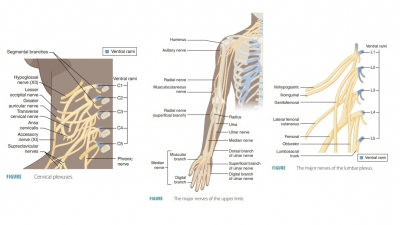Summary
| Home | | Anatomy and Physiology | | Anatomy and Physiology Health Education (APHE) |Chapter: Anatomy and Physiology for Health Professionals: Central Nervous System
The human brain controls movements, sensations, consciousness, and cognitive abilities.
Summary
The human brain controls
movements, sensations, consciousness, and cognitive abilities. The adult brain
is divided into the cerebrum (with cerebral hemispheres), diencephalon, brain
stem, and cere-bellum. The cerebral hemispheres and cerebellum contain the
nuclei of gray matter surrounded by white matter and an outer gray matter
cortex. Each cerebral hemisphere consists of the cerebral cortex, cerebral
white matter, and basal nuclei (ganglia). The cerebral hemispheres each receive
sensations from and dispatch motor impulses to the opposite side of the body.
The brain contains four ventricles filled with CSF. It is covered by
convolutions, gyri, sulci, and fissures.
The diencephalon includes the
thalamus, hypo-thalamus, and epithalamus. The hypothalamus con-trols the ANS
and part of the limbic system as well as gastrointestinal activity, body
temperature, and ante-rior pituitary gland activity. The brain stem includes
the midbrain, pons, and medulla oblongata. The cerebellum also has two
hemispheres and interprets impulses from the motor cortex and sensory
path-ways. It coordinates motor activity in the body. The limbic system is the
emotional–visceral part of the brain, and also plays a role in memory.
Patterns of electrical activity
in the brain are called brain waves, which can be recorded by an EEG. Brain
waves include alpha, beta, theta, and delta waves. Consciousness has four basic
components: alertness, drowsiness, stupor, and coma. Sleep is a state of
partial consciousness from which a person can be aroused by stimuli. The two
major types of sleep are NREM and REM sleep. There are four stages of NREM
sleep, leading to restorative slow-wave sleep. Then, as alpha waves return, REM
sleep begins, and most dreaming will occur in this phase. Sleep and wakefulness
occur in natural 24-hour circadian rhythms. Deprivation of REM sleep can result
in various personality disorders.
In most people, the left brain
hemisphere controls language, whereas the right brain hemisphere controls the
emotional content of language. Memory storage includes short-term and long-term
memory. Mem-ories transferred to long-term memory become per-manent, but this
takes time. The brain is protected by the meninges, CSF, and the blood–brain
barrier. The meninges include the dura, arachnoid, and pia mater, which enclose
the brain, spinal cord, and related blood vessels. The brain’s blood supply
brings continuous oxygen and nutrients through the internal carotid and
vertebral arteries. The blood–brain barrier blocks cer-tain molecules from
entering the brain, maintaining a needed stability to the brain environment.
Com-mon brain injuries include trauma, cerebrovascular accidents (strokes), and
degenerative brain disorders (Alzheimer’s, Parkinson’s, and Huntington’s diseases).
The spinal cord is a two-way
impulse conduction pathway and reflex center inside the vertebral column. Each
spinal cord segment is designated by its paired spinal nerves. The central gray
matter of the spinal cord is H-shaped, and each side of its white matter has
dorsal, lateral, and ventral columns known as funiculi, each containing
ascending and descending tracts. Ascending tracts are sensory, whereas
descending tracts are motor. Spinal cord trauma often results in various
degrees of paralysis. As we age, the CNS (pri-marily the brain) decreases in
the amount of neurons, size, and weight. Cognitive abilities may decline in
specific areas or overall.





